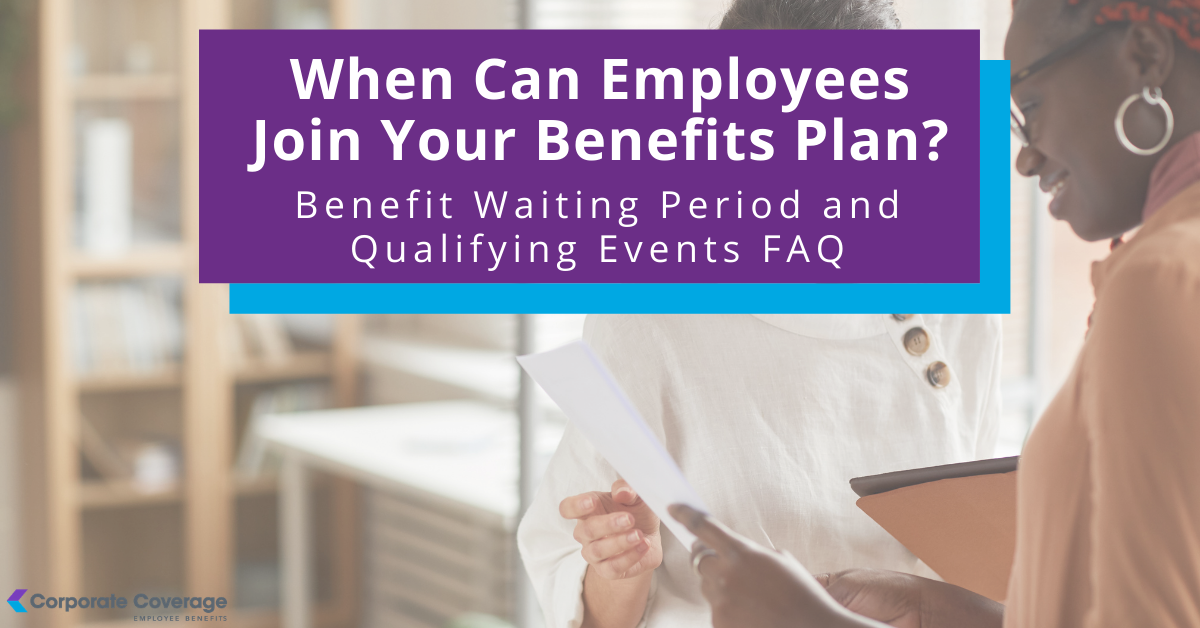When Can Employees Join Your Benefits Plan? Benefit Waiting Periods and Qualifying Events FAQ

Once you’ve set a benefits plan in place, you might feel that you’re set and your employees are ready to go. However, it’s not quite that simple. When a new employee is hired and offered your package, you must stick to the waiting period that was established that determines when they can join the company plan. Want to know more about waiting periods and the qualifying events that apply to them? Keep on reading for the answer to our most frequently asked questions on the topic.
Q: What exactly does the term “waiting period” mean in regards to benefits?
A: When group plans are set up, employers choose the amount of time they would like a new employee to wait before they are eligible to join the company benefit plans. This is known as the waiting period.
Q: Is there a recommended waiting period length?
A: The Affordable Care Act limited the maximum length of the waiting period to 90 days for medical plans. Examples of waiting periods are:
- Date of hire
- 30 or 60 days from date of hire
- First of the month following date of hire
- First of the month following 30 or 60 days from date of hire.
For ease of administration we recommend one of the “first of the month” versions of these options to avoid prorated billing for an employee’s initial enrollment especially when there is an employee payroll deduction.
Generally, if your business has a high turnover of employees you would want to choose a longer waiting period. If your business is in a competitive environment for talent acquisition, you would want to choose a shorter waiting period.
Q: Can I change my waiting period for different employees?
Some insurance companies allow for dual waiting periods for different classes of employees such as professional and non-professional employees.
Insurance companies record your chosen waiting period and most will hold you to it. They do not allow you to “waive” or “extend” the waiting period if desired for a particular employee. Waiting periods can be changed during the year for all employees but the change typically applies to employees hired after the effective date of the change.
Q: What should I know about managing my waiting periods?
It is important that you keep track of your new employee waiting periods so that the employee doesn’t miss their first opportunity to join. Otherwise, they would have to wait until the next anniversary date to enroll. In the case of voluntary coverages such as life insurance or short-term disability, carriers usually provide some amounts of these coverages under a guaranteed-issue basis only if you enroll upon your initial enrollment opportunity. If this is missed, the employee would be considered a late entrant and would be subject to acceptance or rejection via a medical underwriting process. There could be some liability issues for an employer if they did not offer the plans timely to the employee.
Q: Can an employee’s elections be changed during the plan year?
A: Changes are permitted if you experience a qualified life event such as:
- Marriage
- Divorce
- Death of a dependent
- Birth
- Adoption
- Medicare eligibility
- Loss or gain of other employer or government sponsored insurance
If the employee provides documentation to support the qualifying event within 30 days of the event, they would be able to enroll or disenroll in the coverages consistent with the event. The effective date of the change coincides with the date of the qualifying event. For example, if an employee waives the health plan because they are enrolled in their spouse or domestic partner’s plan and that coverage is lost, they would be able to join their company’s plan effective as of the date of the loss.
Q: Anything else I should know about waiting periods and qualifying events?
A: There are some insurance companies that allow employers to manage their own eligibility particularly for larger employers and/or self-insured employers. Also, there could be some restrictions in allowing qualifying events depending upon the provisions of a company’s Section 125 plan premium pretax plan Finally, because life insurance and disability are not governed by the Affordable Care Act, there is more flexibility on waiting periods and they can extend beyond the 90 days.